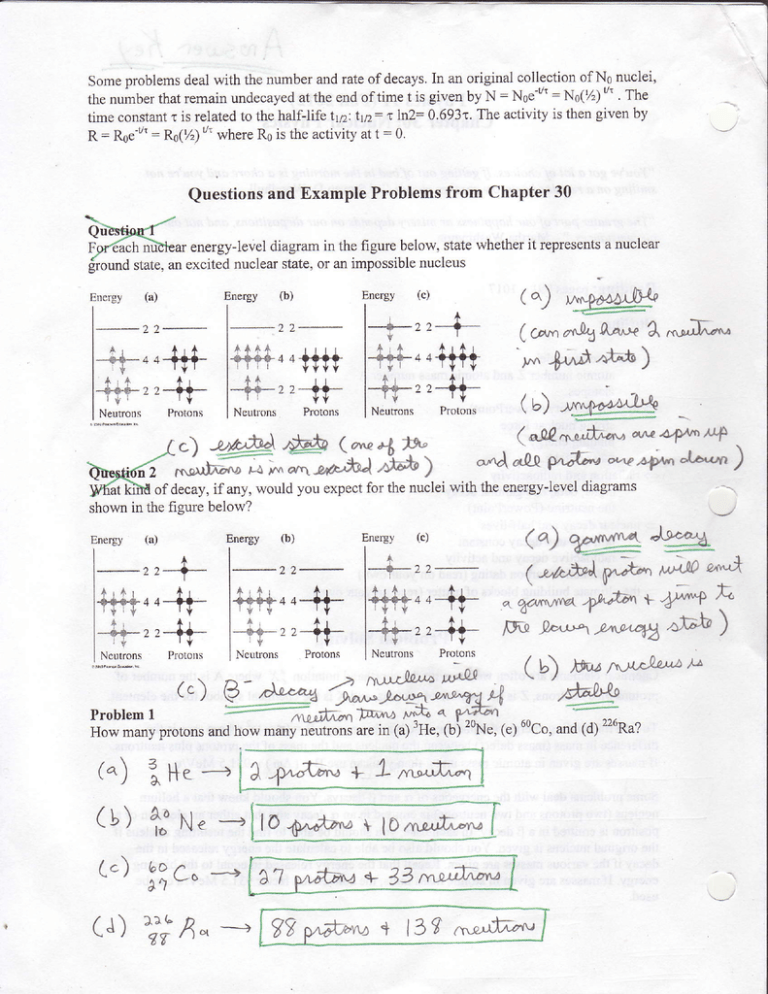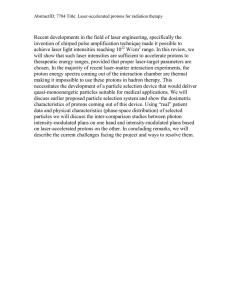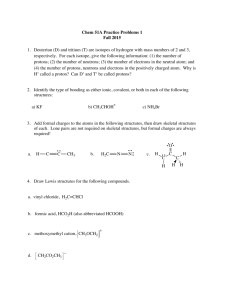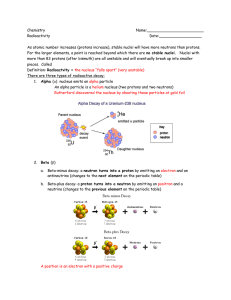(. ) e- d,--^a <AffiA ^ (o) W
advertisement

Someproblemsdeal with the number and rate ofdecays. In an original collection of No nuclei,
u" . The
=
the numberthat remain undecayedat the end of time t is given by N = N6e-v' N(%)
time constantr is related to the half-life hD'.,n: 1,h 2: 0.693t. The activity is then given by
R = Roe-v'=Ro(Y")v'wherc Ro is the activity at t = 0.
Questionsand Example Problemsfrom Chapter 30
aDB.94-
Fqdach nbEar energy-level diagram in the figure below, state whether it representsa nuclear
fround state,an excitednuclearstate,or animpossiblenucleus
Enetgy
(a)
En€rgy
(b)
Energy
-*-"1-
-2
irl
-**s*
22
iv,
Neutrons
4r4r
,v'Y
4r
2 --?!*
l{Ar.
?t+lootftf
fr
-?T*
4 4 J+l
rvl
,lr
-fi*
-ll-'
i;
Protons
Protons
p'mantz*.-*,)zlz*
bnerddi-z f\lrrhtu
(a)ry4
(^tl.n-Mfr*'"o'tv4"V'tn'u+
p.
tAt
-(i) @'$&
)"^ -$r^if ,.fut )
4 *?(1?
z-*lvv
Neutrons
Protons
( - l-.+aaarb&
") -+==:-
(c)
I
'"'d
"l-q P"F-t
-"t*Vt"
Jb'.n)
flrfut ttrU of decay,if any,wouldyou expectfor thenucleiwith theenergyJeveldiagrams
shownin the figure below?
Energy
Eneryy
(a)
-2r-+-
(b)
Eneryy
(a,bbAg.t" -y TA
n'
'^
+
4r'*?
+!^tu^
l{t4t.,+f-l+f+..;.,{t""tr
-2
2-
(o)
(.) e-d,--^a
<AffiA ^ W*'
Protons I Nctrtlons Protons lNcutrons
(c )
Problem|
A dt""A
-rLvdtnpw
'S,on
Prorons
fi
l^,zlttat'q1
4
!'a
r^'u,
/#JbJl!)
---
.^
ouCo,al]d(d) ""Ra?
How manyprotonsand how manyneutronsarein (a)'He. ib;'Ne, (e)
(a, l
(b)
(")
..,_./
<q)ry:g
(c)
.,{t*
4*+f
p'e //s142
^b,b
rru
+,,+
li.-,,+t- l+r"+t.Ll:,:l
-\
boa^
(J) T; A^
)
Problem 2
Mercury tllHg trasan atomic massof 201.970611tt. Obtain the binding energyper nucleon (in
MeV/nucleon).
$;A^"ge'&^qt
f Q n= I , o o ? 8 A 5 u
qryv
B= Axt.cn = (Z mo+ N hn- r"*,.) ' (q3t
)
??a l.Jo --.,
/'€
Yo
mh = I,oo?6b5Ll
\_-,/
to prwt,
ltt^
r1 6
(+*bntha*)
+-
4\UJ)./\.71\A
1 0 u 9= ] o l . q ? 0 6 ) ) \ , \
- lDl.c?oo,tul (
(t.ooa61"s)
ta,A
B = Lzo(r.oo?ea5u)+
q 3 t , L 1 1 l , l e v\
u/
= (t.?rasr3")
(wt'41ry) = l6W
=> Nv,r.o,at2,o)rtu<!-ra,----. .b4d-wy-r4,"'qr4= \9-322+u^, =
,o^FN.94
Problem 3
.b'^sr^qs*q\
ftszloyuy
9:t'1qyl4%) '-B =or."*= (2"*.Nnn+ lYt.*.) x (
f0,r= l"oo?125q
3/-1" ----- ^ p".bM (a*UaWa)
ftln--l.oo?tnt"5..\
'//.ie----rA.p^m"(+"n^w.) + \ ^yfu*
+ I notf,-"
D ulr"= 3.oluoa9q
olq
*uH"= zi.D0).t
(t'oo?r]5*) +1(t.oosto,su)- =.otaoat-] (
q3t't1atN"%)
(4)
B . Il
(u)
-!.ootLoa,f (aa'ttrt=y,
B = [rtt"oo'tEE5*)* J.,(1.oorr,r,5,)
=
= 6,626219" (ouuqtM"Y
)
W"V
ry"o'1'tl&
/\'^tI2rD,\
'l
lle ta r$6a
+=:l
ffi^Pq
0r^*J\
'+-
Problem 4
Draw energy-leveldiagrams.similar
to Figure30.9,for all A = l0 nuclei
listedin AppendixD.
theoccupied
neurron
andpr.t"ril;[.
H;ilit,
\4rbi;lo-ito" ou"r"idoyouexpeci
m be
t,0B
is a stabre nucreus,butt0Be andr0C
are radioactive.r0Be undergoes
bera-minusdecav and
c undergoesbeta-plusdecav-n
u"-it"i
i"J.i," ;";"":""" within the nucreus
proton and an etectron.rn beia_plus
chansesint a
decay,;;;;;"'
;:;;;;;;*o
a neutron and a posilron.
Problem 5
For the following nuclei, eachundergoing
pl 6""ur, write the d
daughter
'"
nucleus,
withitschemical
,y.uoi*o uau",;; il;Tifi"*r"&['re,1p;""it
Ap-.-+ A J)*oo
z
*ore:"'uD-.^:
z+l
i4c-' fi.r, "l
?rr or --=)
-" Tb
/\ - .f /.l
]] o ris
---t {,o"*
F fu
-)
#-',\ F;.a*
EoM , t ='|'ru ^rhr*^
tNl
bha, 7=t3ta .!>,at*ffir(B;)
Problem 6
*"
;:':T:.T,:jy_,fi j1, o**,ffi
daughrer
as
tbep- decayofrhaltium ,!]1.
1
Q- a!.c/e'+
-\
? d"*t
elt*a:
t(
={ -.o&.arJ :
]ra
8q
(v-")
2f -.j, D*_?e-n
?
'o
5 P--j-i p* !,e
^'^e
"[ Q')a44'u
,?
lt-llhn :
t, -* p!r_?. * (v")
"?.1
?T
! y.- ?Trr * | H"
?.o9 n,
ga Ib +
,t
He
A --; ?.ta
z -) t.4
Problem 7,
How many haif-lives must elapseuntil (a) 90% and (b) 99%oof andtoactive sampleof atomshas
decayed?
,
N l = / \rl o f
|
l\
(^)
\
J-/
t / J \ -r //+L, ' t > -
/ l t \
./
q67, 4 f'r''A x' ^x d'ota4tA t ffiea 16Z at aVl
4
pataof ao
-----.o.lDN. = NN --o " loN.
1t/^7t/t,r^
:==-
o,rD -- (\L)r/t"* ----.g1 (o"ro) =),qLA',1.1'"1
L/t,,^ Qa(t/,)
-9n(o. to) =
[ -pn(o"ro)
/-,
L o^ U^)
----+ .U/'1(O.lo) -= t,/-+ ,
--._---:-'tx
-!-. ( '/- )
__+
t,7"
]
t=
'
Problem8
The nurnberof radioactivenuclei presentat the start ofan experimentis 4.60 x 10". The number
What is the half-life (in days)ofthe nuclei?
presenttwentydayslateris 8.14x 1014.
N,
-- 4.oo*
lD's
,q
N = ?.14'lD"
/-^ C
+
Jo 'c'\'^r1,4
-2 -.
(- tJ^ '
N = N" {*/'
NA, = e-'/'
r/
/
I \o
,^ (NA")= )^\ (i't',
1-r( N/X") = -t/-r
ty^. t.p'"\ = (o.t"tz)z = (D,6ra)(rt.S)ft")
tl^'X,ooAaq.o





